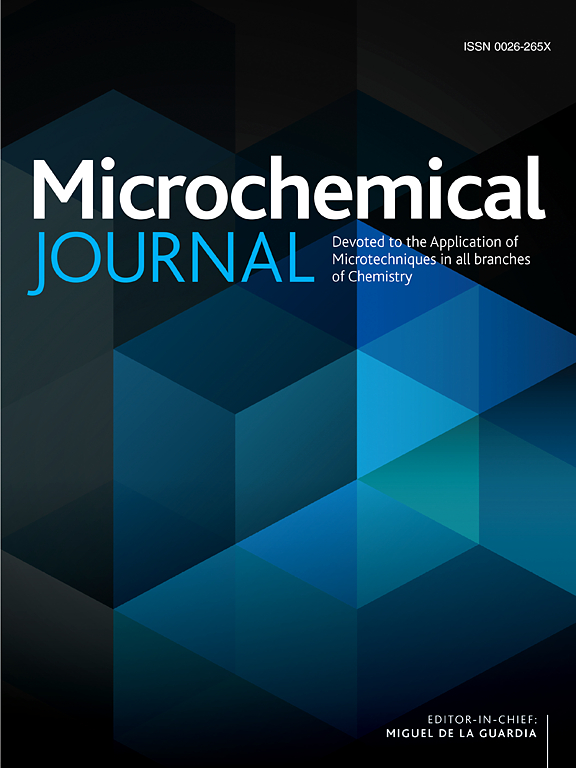A sensitive quantitative method for drug concentrations in blood based on surface-enhanced Raman spectroscopy
IF 4.9
2区 化学
Q1 CHEMISTRY, ANALYTICAL
引用次数: 0
Abstract
The treatment of cardiovascular surgery relies on precise medication management at every stage. Blood contains a wealth of pharmacokinetic and pharmacodynamic information that provides an important basis for personalized drug delivery. Rapid and highly sensitive blood drug concentration assays can dynamically assess the distribution and metabolism of drugs in the body, optimize dose adjustment and improve therapeutic efficacy and safety. This study proposed a new method for real-time monitoring of cardiovascular drugs that combines the surface enhanced Raman spectroscopy (SERS) detection platform with a two-phase extraction strategy. First, silver nanoparticles were synthesized and modified with iodine ions, and calcium ions were further introduced to enhance the stability of the substrate and the Raman signal intensity. Subsequently, common interfering substances in plasma were removed by protein precipitation technology, and drug molecules were rapidly enriched by two-phase extraction to obtain a purer test sample. The experimental results showed that the method had good repeatability (RSD = 2.18 %), the minimum detection concentration of propranolol could reach 10 pg/mL, and the minimum detection limit of atropine was 500 pg/mL. In the SD rat model, the blood concentration of atropine reached a peak at about 2 h after oral administration. In addition, the animal model further demonstrated the ability of this method to accurately monitor the dynamic changes of blood drug concentrations. By comparing with the conventional detection results of UHPLC-MS/MS, the accuracy of this method in quantitative analysis was verified. This study not only expands the application potential of SERS technology in the detection of complex biological samples, but also highlights its broad prospects in drug analysis and clinical individualized treatment.

基于表面增强拉曼光谱的血液中药物浓度的灵敏定量方法
心血管手术的治疗依赖于每个阶段的精准用药管理。血液中含有丰富的药代动力学和药效学信息,为个性化给药提供了重要的基础。快速、高灵敏度的血药浓度测定可以动态评估药物在体内的分布和代谢,优化剂量调整,提高治疗疗效和安全性。本研究提出了一种将表面增强拉曼光谱(SERS)检测平台与两相萃取策略相结合的心血管药物实时监测新方法。首先,合成银纳米粒子,用碘离子修饰银纳米粒子,并进一步引入钙离子来增强基底的稳定性和拉曼信号强度。随后,通过蛋白质沉淀技术去除血浆中常见的干扰物质,并通过两相萃取快速富集药物分子,获得更纯净的测试样品。实验结果表明,该方法重复性好(RSD = 2.18%),对心得洛尔的最低检测浓度可达10 pg/mL,对阿托品的最低检测限为500 pg/mL。在SD大鼠模型中,阿托品血药浓度在给药后约2h达到峰值。此外,动物模型进一步证明了该方法准确监测血药浓度动态变化的能力。通过与常规UHPLC-MS/MS检测结果的比较,验证了该方法定量分析的准确性。本研究不仅拓展了SERS技术在复杂生物样品检测中的应用潜力,也凸显了其在药物分析和临床个体化治疗方面的广阔前景。
本文章由计算机程序翻译,如有差异,请以英文原文为准。
求助全文
约1分钟内获得全文
求助全文
来源期刊

Microchemical Journal
化学-分析化学
CiteScore
8.70
自引率
8.30%
发文量
1131
审稿时长
1.9 months
期刊介绍:
The Microchemical Journal is a peer reviewed journal devoted to all aspects and phases of analytical chemistry and chemical analysis. The Microchemical Journal publishes articles which are at the forefront of modern analytical chemistry and cover innovations in the techniques to the finest possible limits. This includes fundamental aspects, instrumentation, new developments, innovative and novel methods and applications including environmental and clinical field.
Traditional classical analytical methods such as spectrophotometry and titrimetry as well as established instrumentation methods such as flame and graphite furnace atomic absorption spectrometry, gas chromatography, and modified glassy or carbon electrode electrochemical methods will be considered, provided they show significant improvements and novelty compared to the established methods.
 求助内容:
求助内容: 应助结果提醒方式:
应助结果提醒方式:


